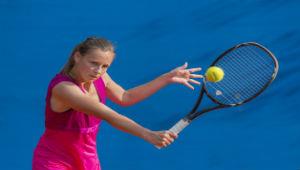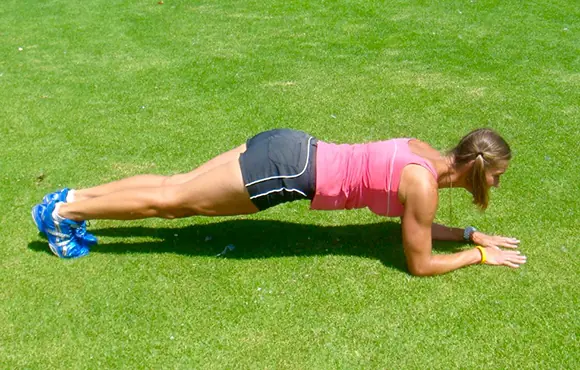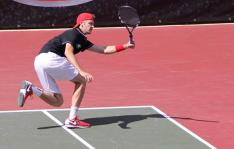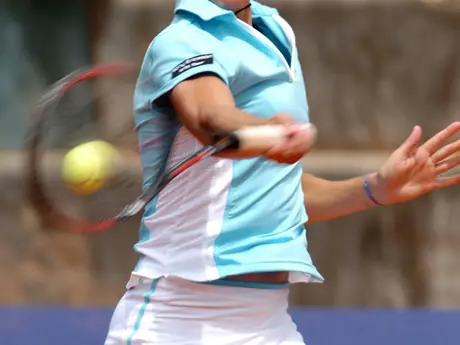The Downward Finish
Tennis Events Near You
Adult Pickleball League
National Trail Parks & Recreation • Springfield, OH
Racquet sports
Adult Advanced Tennis
Columbus Recreation and Parks Department • Columbus, OH
Racquet sports
Adult Tennis- Mixed Doubles League Play
Columbus Recreation and Parks Department • Columbus, OH
Racquet sports
In the last few years, I've also expanded my thinking about the follow-through beyond just the straight-out finish on the drive. It may sound bizarre for me to say, but I now believe that the players can also hit through the ball with a lower finish down and across the body. In fact, I think at higher levels it actually works better.
I'm not a scientist, but I've found from working with some of the best players in the world that they cannot only hit through the ball, they can hit with more spin. If you look at Roger Federer, this is what is happening. It's one of the reasons he has the best forehand in the game.
Finishing across the body isn't something that is totally new, but today it is almost the norm on the pro tour.
I first noticed it myself around 10 years ago watching pro tennis. I always loved to watch the South Americans and the European clay courters play when I would go the US Open. I love watching guys who just fight. And these guys had that mentality. They would just fight, fight, fight.
But when they would get shorter balls you would see them rip the shot with this different finish. They would follow through down, across the body, sometimes way down towards the hip. And they'd just rip winners. And I thought to myself, "What are these guys doing?" To me that was fascinating.
I certainly didn't change my teaching at that time. But as time went on--and I saw more and more players doing it--I started to study this finish, and I experimented with it myself.
I realized if you follow through lower across the body, around the waist or sometimes even lower, the ball doesn't float as much. The ball is being hit so hard today that it sometimes floats with the higher finish. With this lower finish the players were generating tremendous pace but also more spin.
| Roger Federer demonstrates that the extension through the line of the shot can actually be better with the lower finish. |
When you look at Federer, this is what you see: He's coming through the ball, but it doesn't look like he's trying to brush up on the ball. Still he hits heavy spin. So I started teaching players to try the downward finish. What I found was that worked sort of automatically; the same way the up-front finish worked in the old days.
By following through lower, my students could drive the ball hard and have maximum topspin, but without really thinking about it. I tell my players to finish a little lower, but drive through the ball. You're not really trying to hit major spin. It's a natural process where the ball has more spin.
I haven't abandoned the up-front finish. I still have players follow through out front and hold the finish. But at some point I usually teach the lower finish to everybody as well. Strangely enough, I have them hit maybe 20 balls and leave it up front. Then I tell them, "Okay, drive the ball and follow through down." And then sometimes I say, "Okay, drive the ball and follow through up." And I'm looking at how the ball comes off the racket the best.
The ball is being hit harder today than ever and this finish is one reason. As they start driving the ball harder and harder, players find it's much easier to control the ball by coming down with the follow-through. It makes the ball drop down more than with the higher finish.
I call it the downward finish, but it's important to understand how the racket gets to that position. If you watch Federer's forehand, he doesn't just bring it immediately around his body. When watching it on TV it may look like he immediately wraps around. But if you look closely or study it in slow motion, you'll see that the racket comes well out towards the net first.
In fact, with the downward finish, sometimes the racket goes further out toward the net than with the high finish. The extension along the line of the shot may be better. I think the racket can come through the ball a little bit longer.
I work a lot on that shot with kids to give them the confidence that coming down actually works. Once they get used to it, they love doing it because it feels so much more comfortable on the follow-through. The more extreme the grip, the more you follow through down, the better it works. Making a follow-through down low toward your hip with an extreme grip works ten times better than trying to follow through up high with that grip. You can just get a better shot.
1 | 2 | 3 | next >For more in-depth analysis and videos of the world's top players, visit TennisPlayer.net.










Discuss This Article